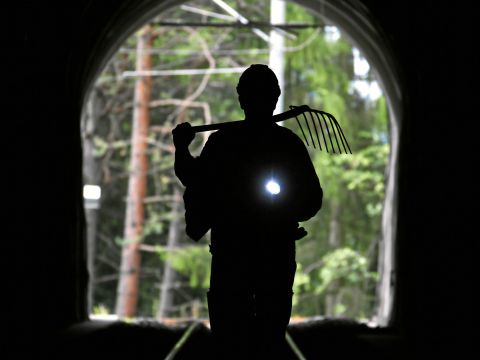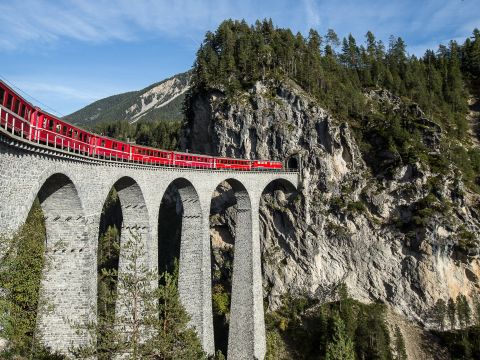The key points in brief – RhB facts and figures

The RhB’s famous mountain railway has now been winding its way through the canton’s towns and villages, from north to south and along valleys dotted with popular tourist attractions, for 125 years. All the facts and figures worth knowing about the success story that is the RhB.
The RhB has been an integral part of the Swiss canton of Graubünden since 1889. In fact, this most beautiful of Swiss landscapes is no longer imaginable without its world-famous railway. The initial spark for its construction actually came from a Dutchman called Willem-Jan Holsboer, now gratefully acknowledged as the railway pioneer who had the vision, back in 1888, to set up a company – Landquart-Davos AG – and drive a narrow-gauge railway through the mountains. The ceremonial first sod of turf was caught in that same year. What began in 1889, with the inauguration of the line from Landquart to Klosters, is now a 394-kilometre long network connecting some of the highest points of this mountainous area of Switzerland. The line links together villages and towns, north and south; along with various outlying valleys that are popular destinations for visitors, while providing a common thread that runs through the region’s social and economic life.
Harmoniously embedded in the heart of nature, the line and its infrastructure actually contribute to Graubünden’s charm. The Albula and Bernina lines, running between Thusis, St. Moritz and Tirano, are masterpieces of the railway builder’s art that fascinate travellers from all over the world. They have enjoyed UNESCO World Heritage status since 2008. The RhB’s Bernina and Glacier Express trains help give the railway its worldwide brand recognition.
The RhB in figures
-
Twelve million passengers travel on the RhB every year
-
The railway’s longest tunnel (the Vereina Tunnel) measures 19,042 metres
-
A team of 1,500 employees maintains the railway’s fascinating set of attractions
-
The trains of the RhB are powered exclusively by locally-generated hydroelectricity
-
The steepest incline (on the Bernina Line) covers 70 mm in one metre
-
30% of the RhB’s lines operate at over 1,500 metres (i.e. nearly a mile) above sea level
-
30% of the RhB’s network has UNESCO World Heritage status
-
20% of the RhB’s lines run over or through some sort of engineering infrastructure (bridges/tunnels)
The line network
The RhB operates a high-performance, 384 km-long line network. Its ten regular interconnected lines serve 103 stations and stopping places. The first line was inaugurated in 1889. Just one year after that, the first trains arrived in Davos, to be followed by operations to St. Moritz, Disentis and Scuol. The merger of the previously separate Arosa and Bernina railways in 1942-1943 quickly expanded the RhB’s line network by a considerable extent. The most-recent extension to the line network took place in 1999, with the construction of the Vereina Tunnel.
The RhB’s line network is an outstanding example of innovative technology applied to improving communications in our high Alpine landscape. The RhB received its ultimate accolade to date in 2008, with the inclusion of the line from Thusis to Tirano in the UNESCO list of World Heritage sites.
|
1889/90 |
Landquart - Klosters - Davos |
||||
|
1896 |
Landquart - Thusis |
||||
|
1903 |
Reichenau - Ilanz (Ruinaulta) |
||||
|
1904 |
Thusis - St. Moritz (Albula) |
||||
|
1909 |
Davos – Filisur |
||||
|
1910 |
St.Moritz - Tirano (Bernina) |
||||
|
1912 |
Ilanz – Disentis/Mustér |
||||
|
1913 |
Bever – Scuol-Tarasp |
||||
|
1914 |
Chur - Arosa |
||||
|
1999 |
Klosters - Lavin/Susch (Vereina) |
||||
|
2008 |
Inclusion of the section from Thusis to Tirano in the UNESCO list of World Heritage sites |

